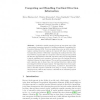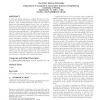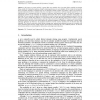83 search results - page 1 / 17 » Computing and Handling Cardinal Direction Information |
EDBT
2004
ACM
14 years 4 months ago
2004
ACM
Qualitative spatial reasoning forms an important part of the commonsense reasoning required for building intelligent Geographical Information Systems (GIS). Previous research has c...
SAC
2010
ACM
14 years 5 months ago
2010
ACM
In GIS and spatial databases, cardinal directions are frequently used as selection and join criteria in query languages. However, most cardinal direction models are only able to h...
DASFAA
2010
IEEE
14 years 5 months ago
2010
IEEE
Abstract. Besides topological relations and approximate relations, cardinal directions have turned out to be an important class of qualitative spatial relations. In spatial databas...
CONSTRAINTS
2007
13 years 11 months ago
2007
In this paper we present Cardinal, a general finite sets constraint solver just made publicly available in ECLiPSe Prolog, suitable for combinatorial problem solving by exploiting ...
DAWAK
2003
Springer
14 years 4 months ago
2003
Springer
View materialization is recognized to be one of the most effective ways to increase the Data Warehouse performance; nevertheless, due to the computational complexity of the techniq...



